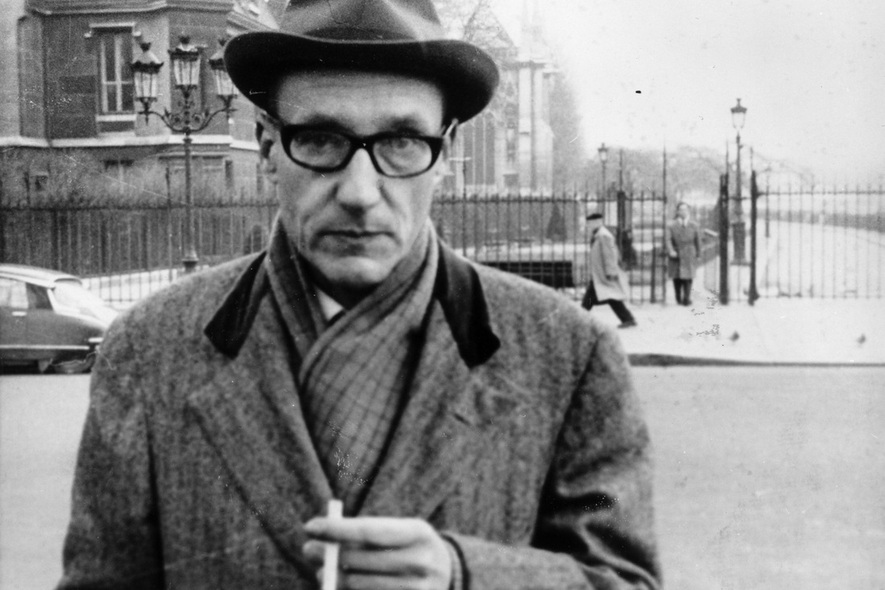William S Burroughs
Biography
William Seward Burroughs II was born 5 February 1914 in St. Louis, Missouri. Burroughs was an innovative writer and artist in many mediums. A progenitor of the Beat Generation, Burroughs went on to deeply influence a wide swath of culture and thought with dozens of books and hundreds of paintings, essays, spoken word performances and multi-media collaborations. The relevance of this work persists in modern times as he made many prescienct predictions of technological evolution and oversteps of 'Control'. Burroughs' stated purposes included exposing systems of oppression and creating a “mythology for the space age.”
After graduating Harvard in 1936, Burroughs followed his fascinations through the underworlds and subcultures of Europe. He went on to live in many cities including New York, where he co-wrote And the Hippos Were Boiled in their Tanks with Jack Kerouac; Tangiers, where he wrote Naked Lunch and explored Morroccan magic; Paris, where he developed the 'cut-up' method; and London, where he wrote the Nova Trilogy and experimented extensively in sound and film. Much of his work is drawn from personal experience in various corners of the world. Diverse settings and subjects are often mixed together in his non-linear novels.
Burroughs found inspiration in many fields of research. His books and essays reveal detailed knowledges of Egyptian mythology, Western civilization, shamanistic practices, centipedes, advertising techniques, firearms, pirates, and much more. A vocal opponent of the War on Drugs, Burroughs experimented rigorously with the effects and uses of mind-altering substances. In The Yage Letters, one can follow his correspondence with Allen Ginsberg as he traveled to South America in search of the drug rumored to promote telepathic abilities. At the request of Timothy Leary, Burroughs tested and reported on psilocybin ingestion. His writings often reveal the struggles of an opiate addict and reflections on the power of addiction.
His greatest collaborator was artist/writer/inventor Brion Gysin and their long friendship led to many of Burroughs' greatest breakthroughs. After complaining that writing was “50 years behind painting,” Gysin discovered and introduced Burroughs to the 'cut-up' method. With this technique the two proceeded to dis-assemble and re-appropopriate written and spoken language. Burroughs was very inspired by the unforeseen connections and associations which appeared in random montages of words and images, reporting that “When you cut into the present, the future leaks out.”
Burroughs was informed by a lifetime of dialogue with provocative and penetrating thinkers. Often these interactions sparked new directions in writing, film, sound, and visual art. Notable collaborators include Antony Balch, Ian Sommerville, Jack Kerouac, Allen Ginsberg, Keith Haring, Robert Rauschenberg, George Condo, Philip Taaffe, Robert Wilson, Tom Waits, Kurt Cobain, John Giorno, Terry Southern, Sinclair Beiles, & Gregory Corso.
In 1981, Burroughs followed his manager/editor, James Grauerholz back to the Midwest, to Lawrence, Kansas where he wrote the Red Night Trilogy, began performing spoken word, and developed a range of painting techniques. Until his late years, he prolifically created visual art which has since been featured in over fifty international galleries and museums. He continued writing until the day he died. On 2 August 1997, Burroughs passed away at home at the age of 83.
by Yuri Zupančič, 23rd September 2013.
SOURCE : http://www.burroughs100.com/william-s-burroughs-biography
After graduating Harvard in 1936, Burroughs followed his fascinations through the underworlds and subcultures of Europe. He went on to live in many cities including New York, where he co-wrote And the Hippos Were Boiled in their Tanks with Jack Kerouac; Tangiers, where he wrote Naked Lunch and explored Morroccan magic; Paris, where he developed the 'cut-up' method; and London, where he wrote the Nova Trilogy and experimented extensively in sound and film. Much of his work is drawn from personal experience in various corners of the world. Diverse settings and subjects are often mixed together in his non-linear novels.
Burroughs found inspiration in many fields of research. His books and essays reveal detailed knowledges of Egyptian mythology, Western civilization, shamanistic practices, centipedes, advertising techniques, firearms, pirates, and much more. A vocal opponent of the War on Drugs, Burroughs experimented rigorously with the effects and uses of mind-altering substances. In The Yage Letters, one can follow his correspondence with Allen Ginsberg as he traveled to South America in search of the drug rumored to promote telepathic abilities. At the request of Timothy Leary, Burroughs tested and reported on psilocybin ingestion. His writings often reveal the struggles of an opiate addict and reflections on the power of addiction.
His greatest collaborator was artist/writer/inventor Brion Gysin and their long friendship led to many of Burroughs' greatest breakthroughs. After complaining that writing was “50 years behind painting,” Gysin discovered and introduced Burroughs to the 'cut-up' method. With this technique the two proceeded to dis-assemble and re-appropopriate written and spoken language. Burroughs was very inspired by the unforeseen connections and associations which appeared in random montages of words and images, reporting that “When you cut into the present, the future leaks out.”
Burroughs was informed by a lifetime of dialogue with provocative and penetrating thinkers. Often these interactions sparked new directions in writing, film, sound, and visual art. Notable collaborators include Antony Balch, Ian Sommerville, Jack Kerouac, Allen Ginsberg, Keith Haring, Robert Rauschenberg, George Condo, Philip Taaffe, Robert Wilson, Tom Waits, Kurt Cobain, John Giorno, Terry Southern, Sinclair Beiles, & Gregory Corso.
In 1981, Burroughs followed his manager/editor, James Grauerholz back to the Midwest, to Lawrence, Kansas where he wrote the Red Night Trilogy, began performing spoken word, and developed a range of painting techniques. Until his late years, he prolifically created visual art which has since been featured in over fifty international galleries and museums. He continued writing until the day he died. On 2 August 1997, Burroughs passed away at home at the age of 83.
by Yuri Zupančič, 23rd September 2013.
SOURCE : http://www.burroughs100.com/william-s-burroughs-biography


